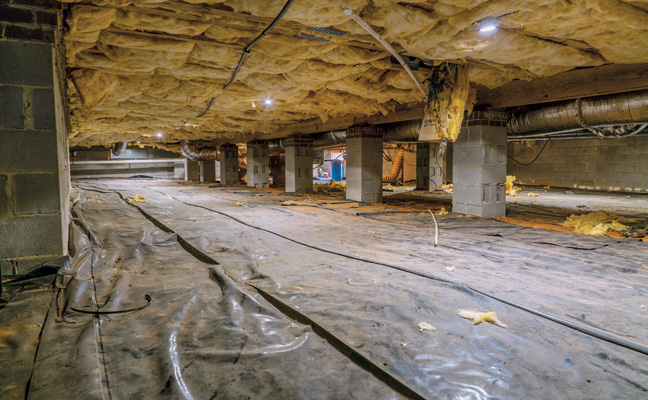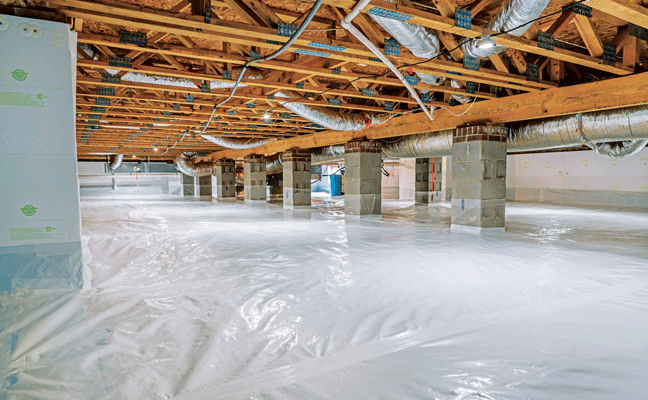
A “before” shot. PHOTO: CRAWLSPACE DEPOT
The consumer-targeted website Crawlspaces.org, maintained by nonprofit energy firm Advanced Energy, features an article with an interesting take on the concept of encapsulating, or “closing,” crawlspaces and basements with energy-efficient vapor barriers and insulation. The article directs consumers to think of the crawlspace as a plastic container for leftovers:
A closed crawlspace needs to be sealed tight, so no outside air gets inside. To build this airtight box, the contractor will install plastic sheeting over the soil plus the masonry walls and piers, overlapping and sealing the seams. They will also seal all holes and gaps linking the crawlspace to the great outdoors and the interior of your home with caulk or foam. This includes installing weather-stripping on the crawlspace doors and covering crawlspace vents with rigid foam or wood. Once all six sides of this crawlspace “box” are sealed, insulation should be installed either on the perimeter walls or touching the wood subfloor.
The website overall urges consumers to leave this work to the professionals. And pest management professionals (PMPs) happen to be well-equipped to add this service, thanks to their common presence in crawlspaces for inspections anyway.
PMP Hall of Famer (Class of 2017) Billy Tesh embodies this idea. In the late 1990s, the president of Pest Management Systems — who started the Greensboro, N.C.-based company a decade before, while still in his 20s — began seriously looking at why so many of his customers complained of “sweating” crawlspaces that additional ventilation wasn’t helping. Tesh teamed up with Advanced Energy to conduct some research, and to dispel the myth that having closed crawlspaces would lead the homes to rot. Along the way, known as the first PMP doing this type of work and finding it hard to source materials, he founded sister company Crawlspace Depot as a clearinghouse for supplies and equipment.
“In 2002, when we started looking at the closed crawlspace arena and I made trips around the country talking to PMPs about closed crawlspaces — even then, the industry was worried about the negative impact of them doing that work” because of the rot myth, he says. With that myth since put to rest, and the proven energy savings prominently touted in it today, Tesh says, it’s come full circle.
“Now, PMPs realize it’s a service that is needed by customers, and they don’t want to see another entity doing that work,” he says. “PMPs are the ones heavily engaged in that realm of that structure, so we should be the only ones sealing it because we know what all is going on under the house.”

The “after” with a vapor barrier and borate-impregnated foamboard insulation installed. PHOTO: CRAWLSPACE DEPOT
DO YOUR HOMEWORK
There are a variety of crawlspace solutions available, including TAP’s ComfortTherm fiberglass insulation and Crawlspace Depot’s insulation and encapsulation products. Whether starting or streamlining the process, Tesh emphasizes you must know your current local market specifications and energy codes. A good resource to locate local R-value requirements, for example, is the Responsible Energy Codes Alliance’s website.

Billy Tesh
After familiarizing yourself with the applicable building codes in your market, Tesh advises starting at a level with which you’re comfortable. Online and in-person training is available from product manufacturers and distributors, he adds.
One benefit to offering crawlspace encapsulation is that you can keep your termite technicians busy in the winter between jobs. While a typical home can be encapsulated in two to three days by one person, Tesh says it’s better to have two and best to have three. With four, however, people can get in one another’s way.
“One person can stay outside cutting and measuring, then the other two can transfer materials back and forth,” Tesh explains, joking that “since there’s only one hole to get in and out of, you only want to make one trip if you can.”
His company started offering the system two decades ago by hitching a trailer for equipment to one of its existing termite rigs. Today, Pest Management Systems has four trucks devoted just to encapsulating crawlspaces. The company also sells annual renewals, just like it would with a termite program. The renewal gives the company the chance to replace monitoring batteries as appropriate.
Tesh notes the renewal inspection also allows a PMP to get in and ensure there are no plumbing leaks, or tears from a cable technician or electrician who performed work and ignored the signs posted to leave the system as intact as they found it. To protect the system, his company posts notice signs at the crawlspace entrance that holds the outside contractor liable for costs related to repair work.
“We’ve gotten to the point with some contractors where we say, ‘Why would you disrupt our system? Would you do that to sheetrock? Of course not. This, too, has an intended purpose that disturbing will invalidate,’” he says.
PROFITABLE PROPOSITION
Tesh has helped many PMPs get their encapsulation service off the ground, and has fine-tuned his own company’s program over the years. He has found that hourly pay to the termite crew works, but adding a production bonus is what really gets employees to buy in.
“We keep a spreadsheet that calculates every factor, really breaking down time, labor and materials,” he explains. “When we run the calculations and come up with the profitability ratio, we can award a bonus to crews who do quality work on time and on budget.” He notes that his crews run nearly like clockwork as result.
Tesh says he foresees closed crawlspaces only growing in popularity as more builders and homeowners seek energy-efficient solutions. There’s another bonus, too, he says:
“Our company offers both attic insulation and crawlspace encapsulation services. But during a North Carolina summer, when the attic temperature gets to be 200°F and we can’t feasibly get an insulation job done that day, we certainly can schedule one for a crawlspace, where it’s much cooler!”
LINKS TO GET YOU STARTED
Provided by Andrew Hicks, director of operations at Crawlspace Depot.
- Download a free PDF of Crawlspace Depot’s equipment and inspection checklist here.
- Many states have adopted the International Residential Building Code R408.3, which is detailed online at Codes.iccsafe.org/content/IRC2018/chapter-4-foundations.
- Some states, like North Carolina, have their own code, which is detailed online at Codes.iccsafe.org/content/NCRC2018/chapter-4-foundations.
Read more:
Leave A Comment